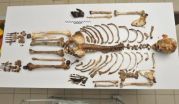(Press-News.org) Scientists at The University of Manchester have made a surprising finding after studying how tadpoles re-grow their tails which could have big implications for research into human healing and regeneration.
It is generally appreciated that frogs and salamanders have remarkable regenerative capacities, in contrast to mammals, including humans. For example, if a tadpole loses its tail a new one will regenerate within a week. For several years Professor Enrique Amaya and his team at The Healing Foundation Centre in the Faculty of Life Sciences have been trying to better understand the regeneration process, in the hope of eventually using this information to find new therapies that will improve the ability of humans to heal and regenerate better.
In an earlier study, Professor Amaya's group identified which genes were activated during tail regeneration. Unexpectedly, that study showed that several genes that are involved in metabolism are activated, in particular those that are linked to the production of reactive oxygen species (ROS) - chemically reactive molecules containing oxygen. What was unusually about those findings is that ROS are commonly believed to be harmful to cells.
Professor Amaya and his group decided to follow up on this unexpected result and their new findings will be published in the next issue of Nature Cell Biology.
To examine ROS during tail regeneration, they measured the level of H2O2 (hydrogen peroxide, a common reactive oxygen species in cells) using a fluorescent molecule that changes light emission properties in the presence of H2O2. Using this advanced form of imaging, Professor Amaya and his group were able to show that a marked increase in H2O2 occurs following tail amputation and interestingly, they showed that the H2O2 levels remained elevated during the entire tail regeneration process, which lasts several days.
Talking about the research Professor Amaya says: "We were very surprised to find these high levels of ROS during tail regeneration. Traditionally, ROS have been thought to have a negative impact on cells. But in this case they seemed to be having a positive impact on tail re-growth."
To assess how vital the presence of ROS are in the regeneration process, Professor Amaya's team limited ROS production using two methods. The first was by using chemicals, including an antioxidant, and the second was by removing a gene responsible for ROS production. In both cases the regeneration process was inhibited and the tadpole tail did not grow back.
Professor Amaya says: "When we decreased ROS levels, tissue growth and regeneration failed to occur. Our research suggests that ROS are essential to initiate and sustain the regeneration response. We also found that ROS production is essential to activate Wnt signalling, which has been implicated in essentially every studied regeneration system, including those found in humans. It was also striking that our study showed that antioxidants had such a negative impact on tissue regrowth, as we are often told that antioxidants should be beneficial to health."
The publication of Professor Amaya's study comes just days after a paper from the Nobel Prize winner and co-discoverer of the structure of DNA, James Watson, who has suggested antioxidants could be harmful to people in the later stages of cancer.
Professor Amaya comments: "It's very interesting that two papers suggesting that antioxidants may not always be beneficial have been published recently. Our findings and those of others are leading to a reversal in our thinking about the relative beneficial versus harmful effects that oxidants and antioxidants may have on human health, and indeed that oxidants, such as ROS, may play some important beneficial roles in healing and regeneration."
The next step for the team at the Healing Foundation Centre will be to study ROS and their role in the healing and regenerative processes more closely. With a better understanding, Professor Amaya and his team hope to apply their findings to human health to identify whether manipulating ROS levels in the body could improve our ability to heal and regenerate tissues better. Thus these findings have very important implications in regenerative medicine.
### END
PHILADELPHIA - It is perhaps impossible to overstate the importance of the tumor suppressor gene p53. It is the single most frequently mutated gene in human tumors. p53 keeps pre-cancerous cells in check by causing cells, among other things, to become senescent – aging at the cellular level. Loss of p53 causes cells to ignore the cellular signals that would normally make mutant or damaged cells die or stop growing.
In short, the p53 pathway is an obvious and attractive target for drug developers. But that strategy has so far proven difficult, as most p53 regulatory proteins ...
January 13, 2013, Fujian and Shenzhen, China- An international research consortium, led by Fujian Agriculture, Forestry University (FAFU) and BGI, has completed the first genome sequence of the diamondback moth (DBM), the most destructive pest of brassica crops. This work provides wider insights into insect adaptation to host plant and opens new ways for more sustainable pest management. The latest study was published online today in Nature Genetics.
The diamondback moth (Plutella xylostella) preferentially feeds on economically important food crops such as rapeseed, cauliflower ...
A new method of establishing hair and eye colour from modern forensic samples can also be used to identify details from ancient human remains, finds a new study published in BioMed Central's open access journal Investigative Genetics. The HIrisPlex DNA analysis system was able to reconstruct hair and eye colour from teeth up to 800 years old, including the Polish General Wladyslaw Sikorski (1881 to 1943) confirming his blue eyes and blond hair.
A team of researchers from Poland and the Netherlands, who recently developed the HIrisPlex system for forensic analysis, have ...
Scientists at the Universities of York and Leeds have made a significant discovery about the cause of the destruction of ozone over oceans.
They have established that the majority of ozone-depleting iodine oxide observed over the remote ocean comes from a previously unknown marine source.
The research team found that the principal source of iodine oxide can be explained by emissions of hypoiodous acid (HOI) – a gas not yet considered as being released from the ocean – along with a contribution from molecular iodine (I2).
Since the 1970s when methyl iodide (CH3I) was ...
Writing in Nature Materials, the scientists, working with colleagues from Aix-Marseille University, have created a device which potentially can see one molecule though a simple optical system and can analyse its components within minutes. This uses plasmonics – the study of vibrations of electrons in different materials.
The breakthrough could allow for rapid and more accurate drug testing for professional athletes as it could detect the presence of even trace amounts of a substance.
It could also be used at airports or other high-security locations to prevent would-be ...
This press release is available in French and German.
Jointly issued with STFC and the Royal Veterinary College London.
Scientists have been able to reconstruct, for the first time, the intricate three-dimensional structure of the backbone of early tetrapods, the earliest four-legged animals. High-energy X-rays and a new data extraction protocol allowed the researchers to reconstruct the backbones of the 360 million year old fossils in exceptional detail and shed new light on how the first vertebrates moved from water onto land. The results are published 13 January ...
Researchers at McGill University and the Research Center for Molecular Medicine (CeMM) of the Austrian Academy of Sciences have discovered the molecular blueprint behind the IFIT protein. This key protein enables the human immune system to detect viruses and prevent infection by acting as foot soldiers guarding the body against infection. They recognize foreign viral ribonucleic acid (RNA) produced by the virus and act as defender molecules by potentially latching onto the genome of the virus and preventing it from making copies of itself, blocking infection. The findings ...
Smoking not only causes bladder cancer—it also affects its course, in that people who smoke more have greater likelihood of developing more aggressive and deadly disease. That is one of the conclusions of a new study published early online in CANCER, a peer-reviewed journal of the American Cancer Society. The study also found that a panel of bladder cancer markers can predict which particular cases are at the highest risk for a fatal outcome.
Researchers have known that smoking is one of the most common causes of bladder cancer, but they've wondered whether it also affects ...
A new study highlights the risk that female teenagers face when they go online – a risk heightened for teen girls who have been victims of abuse or neglect.
The study, published in the eFirst pages of the journal Pediatrics, shows that 30 percent of teenagers reported having offline meetings with people they have met on the Internet and whose identity had not been fully confirmed prior to the meeting.
"These meetings may have been benign, but for an adolescent girl to do it is dangerous," says Jennie Noll, PhD, a psychologist at Cincinnati Children's Hospital Medical ...
SEATTLE—Children age 12 to 35 months who receive DTaP vaccine in their thigh muscle rather than their arm are around half as likely to be brought in for medical attention for an injection-site reaction. So says a new study of 1.4 million children at Group Health and seven other Vaccine Safety Datalink (VSD) centers across the country, e-published on January 14 in Pediatrics.
"These local reactions are the most common side effect of vaccinations," said study leader Lisa A. Jackson, MD, MPH, a senior investigator at Group Health Research Institute. "But we have known relatively ...


